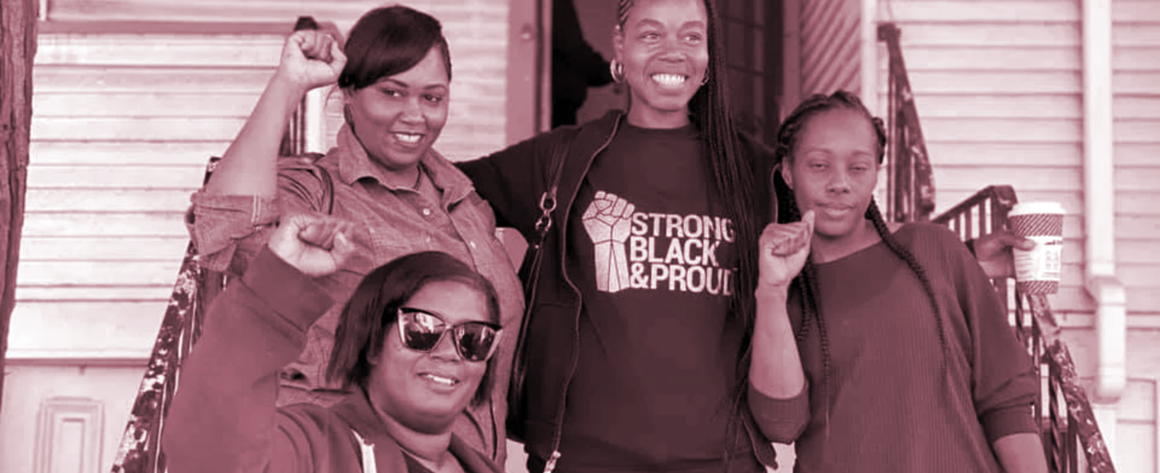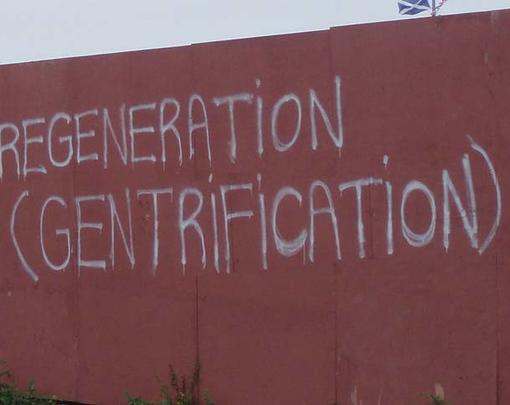Photo: Members of Moms 4 Housing who successfully took possession of an investor-owned house in Oakland, California. (Moms 4 Housing)
California’s Bay Area is home to one of the country’s worst housing crises, where despite soaring rents there are still far more empty homes than unhoused people. In late January 2020, a group of unhoused mothers—organizing under the name “Moms 4 Housing”—took matters into their own hands, occupying a home in West Oakland that had been vacant for two years. Despite their violent police eviction, the moms had overwhelming community support and media attention. Their occupation and organizing resulted in a historic win not only for the right to housing but also for a burgeoning strategy that communities are using to combat decades of racist housing policies, displacement, and gentrification.
The property’s absentee landowners, Wedgewood Properties, agreed to sell the home to the Oakland Community Land Trust, a nonprofit that buys land to maintain permanent affordable housing for low-income communities.
Though there is sometimes disagreement about how to define and measure displacement and gentrification (with some pompous claims that it’s not even a bad thing), the public and private strategies of disinvestment—which have long incubated the concentrated poverty experienced by communities of color—are undeniable: redlining, exploitative financial practices, white flight, tenant harassment, and predatory housing courts have resulted in the structural racism that undergirds our nation’s housing crisis.
The continued struggle of Moms 4 Housing is worth paying attention to; it is a testament to both the real-world legacies of racist housing inequity as well as the tactics that communities are using to fight back. Here, we profile some of the strategies communities and policymakers are using to combat displacement and gentrification, to instead build and fortify community wealth.
Community land trusts
Community land trusts (CLTs) are agreements between a nonprofit and a community that ensure the long-term affordability of housing. Generally, a nonprofit—which has community-members on the board to ensure that it serves the community’s needs—buys land and leases parcels to individuals or families at an affordable price, separating the cost of the land from the cost of housing. Though residents can build some equity, they can’t sell the homes for large profits, which ensures that the CLT can keep the homes affordable for future residents. A 2017 study found that CLTs provide a number of community wealth-building opportunities, a fact illustrated by the more than 200 CLTs across the nation and their current-day resurgence.
Community land trusts have a long history of wealth-building among disenfranchised Black communities, from originally providing new landowning opportunities for Black farmers in Georgia, to kicking off a new wave of community resilience in Boston’s redlined Roxbury neighborhood in the 1980s. The work of the Oakland Community Land Trust (OakCLT), which worked with Moms 4 Housing to secure the West Oakland home, demonstrates how the CLT model can be used to combat the corrosive real estate speculation that pushes Black and Brown residents out of their neighborhoods.
As detailed by Jarrid Green in the Democracy Collaborative’s report “Community Control of Land and Housing,“ since OakCLT was established in the midst of the housing crisis in 2009, it has been strategically building relationships with community members, acquiring properties, and supporting Oakland’s vulnerable communities in building housing security. OakCLT has not only advanced housing equity, but has also stewarded mixed-use spaces for both residential and commercial enterprises, turned vacant lots into urban gardens, and partnered with other organizations to provide job training and food education programs.
New CLTs are under development across the country. In Buffalo, New York, the Fruit Belt Community Land Trust is being established to fortify neighborhoods against expected private development swept in by a new medical campus. In Houston’s Third Ward, a historically Black neighborhood, the city is establishing a city-funded community land trust to ward off the encroaching displacement catalyzed by Texas Southern University and the University of Houston expansion. A CLT in East Austin is combating displacement in its historically Black and Brown communities, who are being pushed out as the city explodes as a tech center. And as San Antonio is groomed to be a new innovation hub, city council members are taking preemptive measures to forestall displacement by establishing CLTs.
Tenant opportunity to purchase
Decades of corporate-friendly zoning policies and pro-developer laws have made stomping out speculative profiteering and the commodification of housing anything but easy. Despite this, communities are organizing and leveraging little-known laws to their advantage. In Washington, DC, one CLT has used a promising new method in the anti-displacement toolkit: taking advantage of a city law that gives tenants preference to buy buildings when they’re up for sale.
The Douglass Community Land Trust in Washington is based in the largely Black and low-income neighborhood of Anacostia. After years of organizing and community outreach, the CLT was incorporated in late 2019 to push back against the expected development pressures wrought by the 11th Street Bridge Park, slated to open in 2023. To preserve their homes in the CLT, community members leveraged the district’s Tenant Opportunity to Purchase Act (TOPA).
Washington’s TOPA, enacted in 1980, has a track record of success: PolicyLink notes that from 2002 to 2013, DC’s TOPA “helped preserve close to 1,400 affordable housing units and keep thousands of long-time, low-income residents in their home.” A law providing a similar right of first refusal to nonprofit housing associations was recently passed in San Francisco. And calls for TOPA to be introduced in other jurisdictions have become louder since the Moms4Housing campaign, with legislation introduced in Oakland itself and New York state. The “right to own”—from residents buying their homes to workers taking control of their workplaces—is a powerful and effective framework for fulfilling the basic needs of marginalized communities. The combination of robust, well-funded public or nonprofit infrastructure dedicated to preserving permanent affordability, together with regulations that give residents or nonprofits accountable to those residents a real chance to acquire properties, is a promising pattern that will hopefully become more widespread.
Community investment trusts
Another framework is being piloted in Portland, Oregon, where communities are stewarding an innovative approach to securing community ownership and control of local properties.
East Portland has seen the city’s fastest increase in housing costs. It’s also home to one of the West Coast’s largest East African populations. Displacement and gentrification would seem to be inevitable.
Not quite. The East Portland Community Investment Trust (EPCIT) was developed to help low-income residents build equity and fight displacement by having community ownership of local property. EPCIT was established in 2015, and incubated by Mercy Corps Northwest, a nonprofit that provides loans and financial education to low-income individuals. As Next City has reported, the trust was born out of conversations between Mercy Corps and renters at an affordable housing development in the neighborhood. The renters wanted to establish roots in their community that provided financial stability, so Mercy Corps helped scout for investment opportunities that were congruent with the residents’ vision and financial constraints.
EPCIT’s first acquisition was Plaza 122, a commercial property in East Portland’s Mill Park neighborhood. Through EPCIT, which now owns the property, individuals or families who live in the four nearby ZIP codes can invest between $10 and $100 (that’s the cap) per month to retain ownership shares in the property.
When Plaza 122 was in foreclosure, it had a two-thirds occupancy rate. Two years after its purchase by EPCIT, it has reached full occupancy and is now home to a variety of people-of-color-owned businesses. As more neighbors invest (EPCIT is set up to accommodate up to 500 investor-owners), they’ll eventually buy out the original investment from Mercy Corps and two private investors. EPCIT is the only one of its kind in the country, though the model is sure to be replicated elsewhere.
Anchor institutions
Alongside the tangible community control of resources such as housing, leveraging anchor institutions can be a powerful tool for equitable development. Hospitals, universities, and other place-based institutions can use local procurement and hiring practices to keep jobs and wealth in communities. In addition, as Jarrid Green and The Democracy Collaborative’s Bich Ha Pham have written, anchor institutions can invest hefty sums into other tools for combating displacement, such as community land trusts.
In Richmond, Virginia, for example, Bon Secours Health System has used its community investment funds to support the Maggie Walker Community Land Trust (MWCLT) and incubate its latest initiative, the Richmond Land Bank. As of 2018, the MWCLT serves as the city of Richmond’s designated lank bank—by all accounts a unique role for a community land trust—by repurposing vacant and tax-delinquent properties for the public interest.
What’s in it for the institutions? Long-term savings. For example, quality, affordable housing has been identified as a key social determinant of health. In late 2019, 14 health systems—members of The Democracy Collaborative’s Healthcare Anchor Network—pledged to invest a staggering $700 million in affordable housing and economic development, making it clear that anchor institutions can be designed to support and benefit communities.
Decommodifying housing
Princeton scholar Keeanga Yamahtta-Taylor has advanced the idea of “predatory inclusion“ to foreground how Black communities have faced continuing dispossession even as racial bias in access to housing markets was ostensibly corrected through federal action against redlining. For Yamahtta-Taylor, the inextricability of real estate as a commodified asset class from America’s deeply racialized geographies and economic stratifications means that market-based solutions to housing inequality will invariably serve to reproduce racialized unequal outcomes, whether on the upswing of gentrification or the downswing of disinvestment.
The ultimate answer to this cycle of dispossession is to decommodify housing. CLTs, for instance, do this to a partial extent, by attenuating the effect of the market on resale values, albeit at a limited scale. A larger vision would have public authorities themselves taking on the role of housing developer—not just creating housing for those at the bottom of the social safety net, but as a major producer of non-luxury housing in general. Vienna, Austria, for instance, has followed this path—with 62% of residents living in social housing (either directly built by the municipality or by tightly regulated nonprofits)—and enjoys some of the most affordable metropolitan housing in Europe as a result. Policymakers in the US have taken notice—with Ilhan Omar’s Homes for All Act authorizing $1 trillion in funding for 12 million new homes over 10 years. At a state level, Maryland state delegate Vaughn Stewart has proposed a 2,000-unit-per-year target for social housing production, focusing on dense, transit-connected construction.
Inclusive financing
Despite Michael Bloomberg’s disturbing attempt to blame the 2008 financial crisis on policies designed to resuscitate the very same communities he victimized as mayor of New York City, it’s clear that decades-long efforts to reverse the racist legacy of redlining have, in fact, made demonstrable progress in extending fair credit to marginalized communities. However, systemic shifts from redlining to predatory inclusion have spawned new, particularly egregious offenders that warrant attention: economic business models designed explicitly around maximum extraction, such as rapacious payday lenders, bail bondsmen, and widespread predatory lending practices.
These extractive practices exacerbate the underlying, structural causes that allow for displacement and gentrification, and part of pushing back is building alternatives that provide the services needed but currently provided by an exclusionary and profiteering financial machine. For instance, credit unions and other community development financial institutions (CDFIs) can equitably extend credit to support local, minority-owned businesses, which are often redlined out of financial opportunities. As Yes! magazine reported, a credit union in New York City’s Lower East Side—a neighborhood that has been the epicenter of gentrification since the 1970s—extends credit to low-income residents to support local business. CDFIs can be a bulwark against these predatory financial institutions by generating local opportunities for wealth creation.
Credit unions can also provide financial services to serve as alternatives to the predatory debt traps of payday loans. Payday alternative loans (PALs), offered by federal credit unions, allow credit union members to borrow small amounts of money at a lower cost than traditional, predatory payday loans and repay the loan over longer periods of time. Creating an ecosystem of non-extractive financial institutions and practices that operate on the principles of inclusion could help communities from being robbed and, ultimately, displaced from their neighborhoods.
Limited equity housing
Limited equity housing cooperatives (LEHCs) are democratically owned and managed by a nonprofit cooperative organization. LEHCs, like community land trusts, limit the equity a member can earn with the home’s resale, preserving the long-term affordability of the housing stock.
As noted by Jarrid Green, LEHCs have a history of combating displacement. One example of this is the Cooper Square Mutual Housing Association, established in New York City in 1991 after decades of local organizing. The effort was spearheaded by the Cooper Square Committee, “an anti-displacement advocacy coalition birthed in response to late-1950s urban renewal policies.”
While the LEHC model has been used for decades, financing opportunities for shared-ownership housing remain limited. Despite this, fair housing advocates have recently won some notable legislative victories that will reduce some of the barriers—organizational as well as financial—to establishing cooperative housing. In 2014, California Governor Jerry Brown signed into law Assembly Bill 569, which removed barriers to financing and establishing democratically owned and managed properties. The bill was spearheaded by a coalition of groups that support affordable and cooperative housing, including the Oakland-based Sustainable Economies Law Center, the California Center for Cooperative Development, and the Bay Area Community Land Trust.
Other solutions
While these efforts—from reorganizing property ownership to creating community-oriented financing opportunities—address the structural inequities that have greased the public-private displacement machine, other, smaller-scale solutions warrant some attention.
Right to Return
One attempted solution has been dubbed the “right to return” policy. First pioneered in Portland, the “Preference Policy” is explicitly mandated to rehouse individuals who have been displaced due to “urban renewal” programs. However, critics—including the NAACP’s Portland branch—have noted that while the policy is meant to address the harm knowingly inflicted upon displaced communities, it frames the issue as race-neutral and does not explicitly address how Black residents were disproportionately affected.
A similar “right to return” program is being piloted in Austin, Texas. In California, the Housing Crisis Act of 2019, recently signed into law, “bans the demolition of affordable and rent-controlled units unless developers replace all of them, pay to rehouse tenants, and offer those renters first right of return at the same rent.”
Despite the flashy name—it’s worth noting that the idea of a “right of return” originally referred to the rights of Palestinian refugees to return to their homes expropriated by Israel—these policies have limited bandwidth for redressing the systemic marginalization of Black and Brown communities. The University of California, Berkeley’s Urban Displacement Project recommends that strategies for combating displacement and gentrification meet the problems at scale. While “right to return” policies can help individual households, they don’t address the structural racism baked into housing and finance practices. A similar policy has been found of limited application in Los Angeles.
Right to Counsel and Rent Control
In early 2019, the Right to the City Alliance, PolicyLink, and the Center for Popular Democracy released a report championing rent control as a way to stabilize neighborhoods at risk of, or already experiencing, gentrification. Not only can rent control and strong tenants unions serve as robust stabilizing measures in predatory housing markets—fortifying residents’ abilities to remain in their homes—these controls also enable tenants to organize without the risk of eviction or retaliatory rent increases.
Pro-tenant, anti-displacement efforts have also focused on providing better legal counsel to tenants facing eviction, a removal process that disproportionately targets Black people—especially Black women—across the country. New York City’s Universal Access to Counsel, established in 2017, was the nation’s first program to provide legal representation for all income-eligible tenants facing eviction in housing court. A similar law was recently passed in Philadelphia. Amid the rollout of other pro-tenant laws, tenants-rights advocates in San Francisco are pushing for funding for their own right to counsel initiative, which passed a ballot measure in 2018. As detailed by the Center for American Progress, a right to legal representation in housing court has been proven to “help tenants win eviction cases and stay in their homes.”
Inclusionary zoning and community benefit agreements
Inclusionary zoning (IZ), also referred to as inclusionary housing, incentivizes private developers to designate a small percentage of units in a given property as below market rate. Though cities such as Detroit have rolled out IZ policies to mitigate displacement, the Urban Institute has found that the policies’ impact is difficult to measure and oftentimes limited in substantively addressing the housing crisis. Since private developers will only produce affordable units so long as they continue to reach their target profit margins, the fraction of affordable units will remain limited.
Community benefit agreements (CBAs) are a promising model of equitable development, though they are not without flaws. A CBA is an agreement between a developer and community representatives that requires the developer to deliver certain community benefits, such as hiring unionized labor. Generally, as with the Kingsbridge Armory in the Bronx, CBAs are signed not so much to stave off development, but to in an organized way wring equitable community returns from private development. However, CBA promises are hard to enforce, and are often broken.
Conclusion
One of the most ambitious strategies for rectifying housing inequities is also one of the oldest: public housing. The Homes Guarantee—a platform advanced by People’s Action, the federation of community and tenant organizations, and developed with the assistance of The Democracy Collaborative’s Peter Gowan—not only envisions 12 million new units of public housing, but also explicitly addresses the need to pay reparations to the Black, Brown, and Indigenous families that have been the victims of decades of racist housing policies. The Homes Guarantee has the support of the country’s most progressive elected officials: In Congress, Minnesota Rep. Ilhan Omar has introduced the Homes for All Act, and Vermont Sen. Bernie Sanders and New York Rep. Alexandria Ocasio Cortez have introduced a Green New Deal for public housing legislation.
Remedying decades of racist housing practices brought about by corporate greed and state complicity is not easy, and the tactics profiled here range from the run-of-the-mill tax-break tinkering to more radical platforms—like the one shouldered by Moms 4 Housing—that advance housing as a human right. What’s clear from this armory of strategies is that Black and Brown communities are fighting to win, and are taking back what has long been reserved for the wealthy and White: the right to a home.




